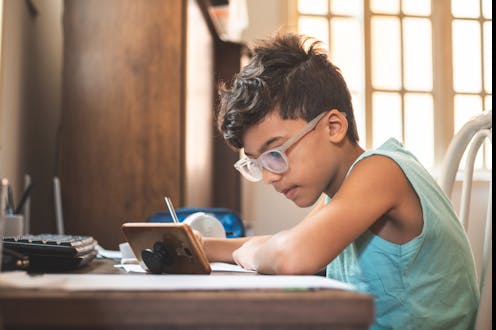How remote learning is making educational inequities worse
- Written by Hernán Galperin, Associate Professor of Communication, USC Annenberg School for Communication and Journalism

The Research Brief[1] is a short take about interesting academic work.
The big idea
The widespread reliance on remote learning is harming students of color from low-income households more than kids who are from more affluent families. Our survey of over 1,000 families in South and East Los Angeles (95% of whom identify as Hispanic and 96% who are on free or reduced-price meals) shows that these students often lack the appropriate technology for learning at home. They also often have parents who must work during school hours or who have limited ability to help their children with online learning. As a result, families in the survey reported lower levels of schoolwork completion and class engagement, two important predictors of academic achievement.
We also found that 57% of the families whose children could use computers for school were staying engaged during distance learning, compared to 43% of the families whose kids had to rely on tablets or smartphones. Likewise, when students can attend live class sessions, which usually requires high-speed internet, they are significantly more likely to complete their schoolwork.
The obstacles to learning away from school went beyond technology. Only one in three of the families we surveyed said they have an appropriate space, free of noise and distractions, in their homes for remote learning and homework. We also found that parents unable to work remotely often struggle to help their children during school hours. Instead, this job falls on older siblings and other relatives.
Why it matters
Our findings[2] highlight the urgency of narrowing the digital divide[3] as a way to improve academic achievement among low-income students of color.
The pioneering American educator Horace Mann[4] famously characterized public schools as the “great equalizer[5],” places where children could receive a high-quality education regardless of individual or family circumstances. Even before the COVID-19 pandemic, this goal was far from realized[6]. But when living rooms and bedrooms become classrooms, disparities in digital technology and support students have at home have a bigger impact than ever. Our research also comes at a time when a group of seven families have sued the State of California[7]. Their lawsuit accuses the state of failing to provide “basic educational equality” during an extended period of remote learning brought about by the COVID-19 pandemic.
What still isn’t known
We conducted this survey in July 2020, shortly after the 2019-20 school year ended. School districts have taken steps to improve remote learning since then by spending more on technology[8].
But there are early indications from the Los Angeles Unified School District[9] and other large school districts that attendance remains lower than it was before the pandemic[10] and that more students than usual are getting failing grades[11]. That troubling news suggests that many of the challenges to remote learning identified in our study may remain largely unresolved.
Another major concern is whether remote learning will affect the transition to college for students who would be the first in their families to continue with their education beyond high school.
What’s next
We are following up by conducting in-depth interviews with Hispanic families to better understand how they are coping with remote learning. We also plan to survey other groups, including Black families and English language learners.
References
- ^ Research Brief (theconversation.com)
- ^ Our findings (rossier.usc.edu)
- ^ digital divide (arnicusc.org)
- ^ Horace Mann (www.britannica.com)
- ^ great equalizer (www.britannica.com)
- ^ far from realized (nces.ed.gov)
- ^ sued the State of California (www.politico.com)
- ^ spending more on technology (theconversation.com)
- ^ Los Angeles Unified School District (www.latimes.com)
- ^ attendance remains lower than it was before the pandemic (bellwethereducation.org)
- ^ more students than usual are getting failing grades (www.nbcnews.com)
Authors: Hernán Galperin, Associate Professor of Communication, USC Annenberg School for Communication and Journalism
Read more https://theconversation.com/how-remote-learning-is-making-educational-inequities-worse-150709

